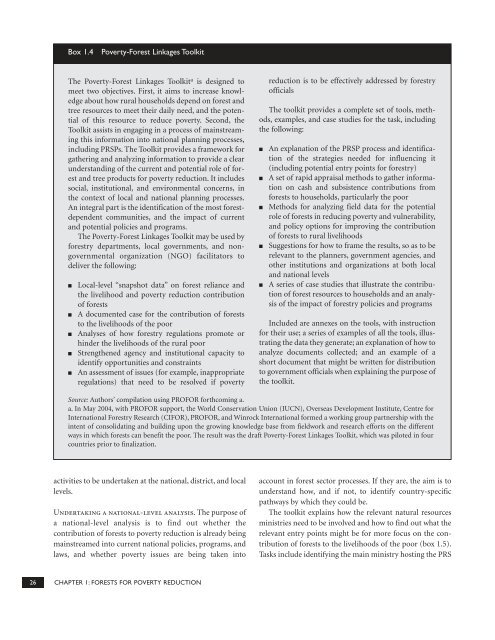Forests Sourcebook - HCV Resource Network
Forests Sourcebook - HCV Resource Network
Forests Sourcebook - HCV Resource Network
You also want an ePaper? Increase the reach of your titles
YUMPU automatically turns print PDFs into web optimized ePapers that Google loves.
Box 1.4<br />
Poverty-Forest Linkages Toolkit<br />
The Poverty-Forest Linkages Toolkit a is designed to<br />
meet two objectives. First, it aims to increase knowledge<br />
about how rural households depend on forest and<br />
tree resources to meet their daily need, and the potential<br />
of this resource to reduce poverty. Second, the<br />
Toolkit assists in engaging in a process of mainstreaming<br />
this information into national planning processes,<br />
including PRSPs. The Toolkit provides a framework for<br />
gathering and analyzing information to provide a clear<br />
understanding of the current and potential role of forest<br />
and tree products for poverty reduction. It includes<br />
social, institutional, and environmental concerns, in<br />
the context of local and national planning processes.<br />
An integral part is the identification of the most forestdependent<br />
communities, and the impact of current<br />
and potential policies and programs.<br />
The Poverty-Forest Linkages Toolkit may be used by<br />
forestry departments, local governments, and nongovernmental<br />
organization (NGO) facilitators to<br />
deliver the following:<br />
■<br />
■<br />
■<br />
■<br />
■<br />
Local-level “snapshot data” on forest reliance and<br />
the livelihood and poverty reduction contribution<br />
of forests<br />
A documented case for the contribution of forests<br />
to the livelihoods of the poor<br />
Analyses of how forestry regulations promote or<br />
hinder the livelihoods of the rural poor<br />
Strengthened agency and institutional capacity to<br />
identify opportunities and constraints<br />
An assessment of issues (for example, inappropriate<br />
regulations) that need to be resolved if poverty<br />
reduction is to be effectively addressed by forestry<br />
officials<br />
The toolkit provides a complete set of tools, methods,<br />
examples, and case studies for the task, including<br />
the following:<br />
■<br />
■<br />
■<br />
■<br />
■<br />
An explanation of the PRSP process and identification<br />
of the strategies needed for influencing it<br />
(including potential entry points for forestry)<br />
A set of rapid appraisal methods to gather information<br />
on cash and subsistence contributions from<br />
forests to households, particularly the poor<br />
Methods for analyzing field data for the potential<br />
role of forests in reducing poverty and vulnerability,<br />
and policy options for improving the contribution<br />
of forests to rural livelihoods<br />
Suggestions for how to frame the results, so as to be<br />
relevant to the planners, government agencies, and<br />
other institutions and organizations at both local<br />
and national levels<br />
A series of case studies that illustrate the contribution<br />
of forest resources to households and an analysis<br />
of the impact of forestry policies and programs<br />
Included are annexes on the tools, with instruction<br />
for their use; a series of examples of all the tools, illustrating<br />
the data they generate; an explanation of how to<br />
analyze documents collected; and an example of a<br />
short document that might be written for distribution<br />
to government officials when explaining the purpose of<br />
the toolkit.<br />
Source: Authors’ compilation using PROFOR forthcoming a.<br />
a. In May 2004, with PROFOR support, the World Conservation Union (IUCN), Overseas Development Institute, Centre for<br />
International Forestry Research (CIFOR), PROFOR, and Winrock International formed a working group partnership with the<br />
intent of consolidating and building upon the growing knowledge base from fieldwork and research efforts on the different<br />
ways in which forests can benefit the poor. The result was the draft Poverty-Forest Linkages Toolkit, which was piloted in four<br />
countries prior to finalization.<br />
activities to be undertaken at the national, district, and local<br />
levels.<br />
Undertaking a national-level analysis. The purpose of<br />
a national-level analysis is to find out whether the<br />
contribution of forests to poverty reduction is already being<br />
mainstreamed into current national policies, programs, and<br />
laws, and whether poverty issues are being taken into<br />
account in forest sector processes. If they are, the aim is to<br />
understand how, and if not, to identify country-specific<br />
pathways by which they could be.<br />
The toolkit explains how the relevant natural resources<br />
ministries need to be involved and how to find out what the<br />
relevant entry points might be for more focus on the contribution<br />
of forests to the livelihoods of the poor (box 1.5).<br />
Tasks include identifying the main ministry hosting the PRS<br />
26 CHAPTER 1: FORESTS FOR POVERTY REDUCTION

















